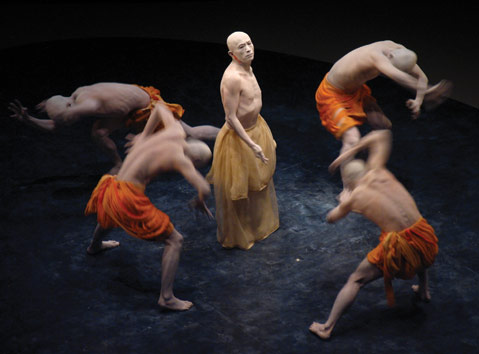Sankai Juku to Perform at the Granada
Butoh Company’s First S.B. Appearance

Photographs of Sankai Juku are striking: bald, bare-chested men covered in white greasepaint stand or kneel in formation. Their long skirts billow around their ankles like monks’ robes. Yet still images can hardly capture the poetry these dancers create in performance. As artistic director Ushio Amagatsu explained over the phone last week, his work needs to be read like poetry—taken in slowly, and savored.
Amagatsu was born in Japan in 1949 and founded butoh company Sankai Juku in 1975. His first international tour won him critical acclaim, and since the early ’80s he’s been based in Paris at Théâtre de la Ville, where he creates a new work every few years. His latest is Tobari—As if in an inexhaustible flux, which takes its name from a Japanese word for a piece of fabric hung between rooms. In conversation with Amagatsu and his translator Kyoko Yoshida, we discussed the metaphor of Tobari, as well as his creative process.
Tobari is a cloth, but it’s also a word that signifies the boundary between day and night. You have also spoken about it in terms of the past being experienced in the present, much the way we experience light from a star only after it is long dead. How do you approach such an abstract concept through movement? You’ve captured the basic concept very clearly, but it’s very difficult to verbalize how I create movement. I would ask the audience to approach or see the work as if they’re reading a poem.
Like poetry, your work can be very spare. Do you aim for simplicity? Yes, and I think, also, it’s my own preference for simplicity. Yet, when things are simple, I want that simplicity to include complexity. I want there to be many elements that can be interpreted.
“Inexhaustible flux” sounds like a description of life itself. Can you talk a little bit more about that concept in Tobari? That’s a beautiful interpretation. “Inexhaustible flux” is part of the subtitle for the dance, and it’s also the name of the sixth scene in the dance. This is my solo. Here I am trying to express the fact that the human being can only experience something in the present tense, even if it happened in the distant past. So that’s a limitation. In this kind of existence there is both sadness and hope.
You talk about the dancers being in dialogue with air, and with gravity. How much of the choreography comes from the dancers’ responses, and how much comes from you as a director? Basically, I choreograph. I wouldn’t say there’s zero percent, but there is very little improvisation in our process. I give certain words or concepts to the dancers, the dancers digest it, and we take it from there. Sometimes I move in order to give them direction.
You are one of the eight performers in Tobari. Can you talk about what it is like both to direct and to perform in a work? That depends on the work—I have danced in other works as well as choreographing and directing. But if I can be bluntly honest, I now appear in less scenes than I used to. It’s just a physical stamina issue. I used to maybe dance in four scenes out of seven or eight, and now maybe I appear in two.
All of the performers in Sankai Juku are male; why is that? In 1975, when I started forming Sankai Juku, I held a yearlong workshop to which 30 men and women came. At the end of the one-year term, only three men were left. Because the three people left were men, I formed the company with them. Of course I don’t have any anything against women—I’ve worked a lot with female dancers, and recently choreographed a short work for Indian female dancers in Paris.
I hear you keep a journal. Tell me how often you add to it, and what kinds of images or notes you’ve jotted down recently. Yes, I like to jot things down. It’s very random; it’s not like I write in it at the end of every day. In terms of recent images, Sankai Juku had a world premiere [Tobari] this past spring, and I downloaded so many ideas into the journal for this new work that right now my journal is empty.
How much do you concern yourself with what an audience experiences or takes away from your work? Sankai Juku’s works are presented in many different countries, and audience members are very diverse in terms of their cultures, countries, languages, everything, so it’s important for me to really focus and concentrate on my own artistry. After that, it’s really up to the audience’s interpretation. That has been my style from the beginning, and I think it will always be.
Is there anything you hope the audience for Tobari might experience? If audience members would be reminded of the humanity and the universality of the human being as a creator, I would be very delighted.
4•1•1
Sankai Juku will perform Tobari—As if in an inexhaustible flux at the Granada on Thursday, October 28. For tickets, call 893-3535 or visit artsandlectures.sa.ucsb.edu.



